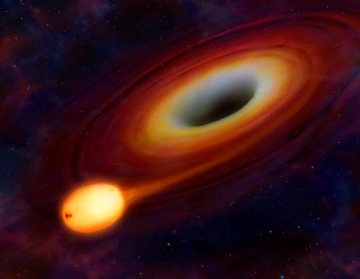
LOS ANGELES (AP) _ Astronomers think they have solved the mystery of an extraordinary flash spied in a faraway galaxy, saying it came from a massive black hole that devoured a star after it wandered too close.
The awesome energy released by the feeding frenzy was first detected by NASA's Swift satellite on March 28 and was later confirmed by a fleet of space and ground telescopes.
Some scientists initially thought the bright flash was a gamma-ray burst from a star collapsing, but flaring from such an event typically lasts only a few hours.
Instead of fading, the cosmic outburst continued to burn bright and emit high-energy radiation that could be observed even today.
Two separate teams pored through data and concluded that an unsuspecting star the size of our sun likely got sucked in by the powerful tug of a giant black hole. Until then, the black hole had been relatively inactive. The findings were published online Thursday in the journal Science.
As the black hole gobbled up the star, it streamed a beam of energy straight at Earth that was recorded by telescopes. The stellar feast occurred in the heart of a galaxy 3.8 billion light years from Earth. A light year is about 6 trillion miles.
``This was clearly different than anything we've ever seen before,'' said one of the team leaders, Joshua Bloom, an astronomer at the University of California, Berkeley who classified the event as extremely rare.
Black holes are swirling, super-dense cores of galaxies that vacuum up nearly everything in sight. How they grow so huge remains a mystery. Scientists think the latest observation could help them better understand how galaxies form.
Could what happened in the distant galaxy occur in our Milky Way? In theory yes, say scientists, but the chances are low.
``It's not something worth losing sleep over,'' said researcher Andrew Levan of University of Warwick in England, who led the other team.
<한글 기사>
먼 은하의 섬광 정체 밝혀져
블랙홀이 큰 별 잡아먹는 현장
먼 은하에서 일시적으로 나오는 강렬한 빛은 너무 가까이 다가온 큰 별을 블랙홀이 잡아먹을 때 나오는 것으로 밝혀졌다.
미국 캘리포니아 버클리 대학과 영국 워릭대학 과학자들은 감마선 우주망원경인 스위프트 위성을 통해 지난 3월28일 이런 현상(Sw 1644+57)을 처음 발견했으며 이어 여러 대의 우주망원경과 지상망원경으로 이를 확인했다고 사이언스지 온라인판인 사이언스 익스프레스에 각각 발표했다.
지금까지 일부 학자들은 이런 섬광을 질량이 큰 별이 붕괴할 때 나오는 감마선 폭발(GRB)로 생각해 왔으나 GRB가 통상 몇 시간 동안만 지속하는 데 비해 Sw 1644+5 7은 첫 발견 후 두 달 반이 지난 지금까지 지속하고 있으며 광원이 은하 중심부라는데 차이가 있다.
두 연구팀은 자료를 분석한 결과 우리 태양 정도 질량을 가진 별이 마치 조용히 앉아있던 개구리에 느닷없이 잡아먹히는 파리처럼 속수무책으로 블랙홀에 빨려 들어 가는 것을 확인했다. 이런 현상은 지구에서 약 38억광년 떨어진 은하 중심부에서 발견됐다.
연구진은 블랙홀에 잡아먹힌 별 질량의 10% 정도가 에너지로 바뀌어 X-선으로 방출되는 것으로 보고 있다.
학자들은 별이 거대한 블랙홀에 잡아먹히는 현장이 과거 X-선이나 가시광선, 자외선 파장에서 관찰된 적은 있으나 감마선 에너지로 포착되기는 처음이라면서 이런 일은 한 은하에서 1억년에 한 번 일어날까 말까 할 정도로 희귀한 현상이라고 밝혔다.
(연합뉴스)
먼 은하의 섬광 정체 밝혀져
블랙홀이 큰 별 잡아먹는 현장
먼 은하에서 일시적으로 나오는 강렬한 빛은 너무 가까이 다가온 큰 별을 블랙홀이 잡아먹을 때 나오는 것으로 밝혀졌다.
미국 캘리포니아 버클리 대학과 영국 워릭대학 과학자들은 감마선 우주망원경인 스위프트 위성을 통해 지난 3월28일 이런 현상(Sw 1644+57)을 처음 발견했으며 이어 여러 대의 우주망원경과 지상망원경으로 이를 확인했다고 사이언스지 온라인판인 사이언스 익스프레스에 각각 발표했다.
지금까지 일부 학자들은 이런 섬광을 질량이 큰 별이 붕괴할 때 나오는 감마선 폭발(GRB)로 생각해 왔으나 GRB가 통상 몇 시간 동안만 지속하는 데 비해 Sw 1644+5 7은 첫 발견 후 두 달 반이 지난 지금까지 지속하고 있으며 광원이 은하 중심부라는데 차이가 있다.
두 연구팀은 자료를 분석한 결과 우리 태양 정도 질량을 가진 별이 마치 조용히 앉아있던 개구리에 느닷없이 잡아먹히는 파리처럼 속수무책으로 블랙홀에 빨려 들어 가는 것을 확인했다. 이런 현상은 지구에서 약 38억광년 떨어진 은하 중심부에서 발견됐다.
연구진은 블랙홀에 잡아먹힌 별 질량의 10% 정도가 에너지로 바뀌어 X-선으로 방출되는 것으로 보고 있다.
학자들은 별이 거대한 블랙홀에 잡아먹히는 현장이 과거 X-선이나 가시광선, 자외선 파장에서 관찰된 적은 있으나 감마선 에너지로 포착되기는 처음이라면서 이런 일은 한 은하에서 1억년에 한 번 일어날까 말까 할 정도로 희귀한 현상이라고 밝혔다.
(연합뉴스)

















![[KH Explains] Hyundai's full hybrid edge to pay off amid slow transition to pure EVs](http://res.heraldm.com/phpwas/restmb_idxmake.php?idx=652&simg=/content/image/2024/04/18/20240418050645_0.jpg&u=20240418181020)

![[Today’s K-pop] Zico drops snippet of collaboration with Jennie](http://res.heraldm.com/phpwas/restmb_idxmake.php?idx=642&simg=/content/image/2024/04/18/20240418050702_0.jpg&u=)